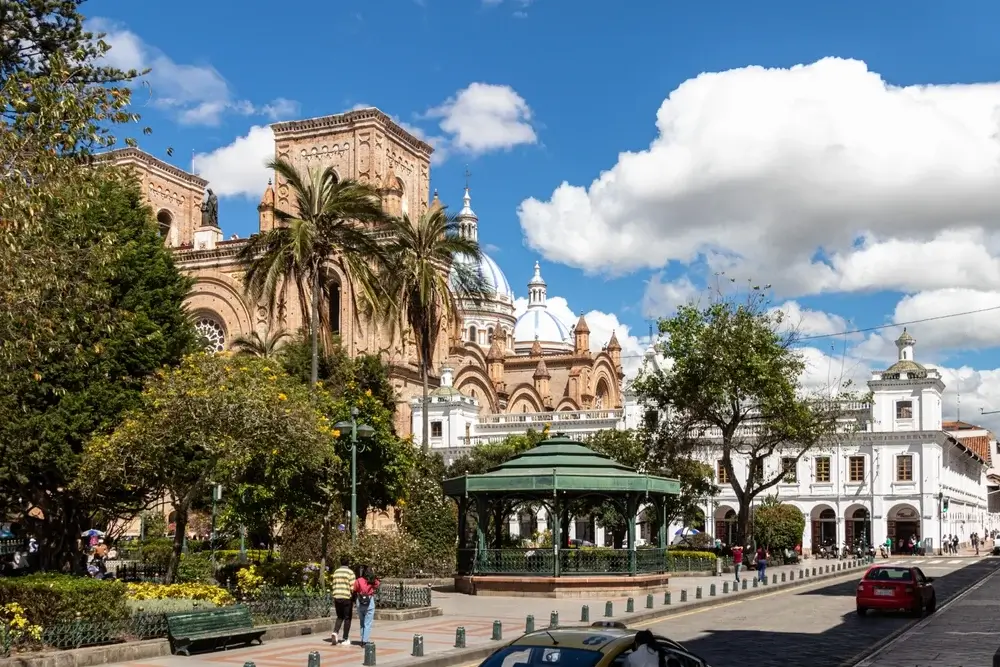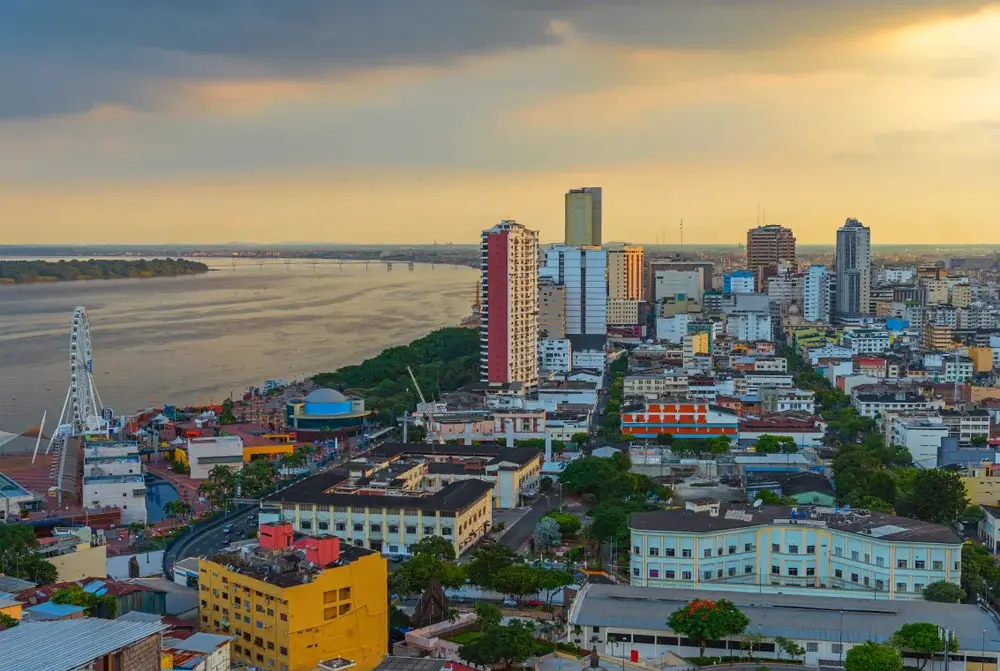Ecuador
Ecuador Country Guide

Ecuador is a country of outstanding contrasts, swaddled in culture and nature. These surely make up unique traveling, striking at the very core of any visitor. The moment one steps off the plane, anticipation fills the air to welcome one into this vibrant world of lush landscapes, bustling markets, and warm smiles of the locals. From the towering Andes peaks to the enchanting biodiversity of the Amazon rainforest, every destination unravels another layer of Ecuadorian charm. You will be allowed to get truly personal with the local traditions, savouring the exquisite flavors of traditional dishes such as ceviche and llapingachos, as you make your way through historical streets of Quito, a UNESCO World Heritage site. This tour is a journey into Ecuadorian culture that, besides letting one appreciate it, connects him to the very essence of it, thus becoming an unforgettable adventure.
Things To Know Before Going To Ecuador
- Ecuador has high-altitude areas like Quito and the Andes; allow time for acclimatization to avoid altitude sickness.
- Drink bottled or boiled water instead of tap water to prevent gastrointestinal issues. This is particularly important in rural areas where water quality may be uncertain.
- Be very careful with your belongings, especially in crowded places and on public transportation. Pickpocketing is extremely common. Make sure to use a money belt, securing your most important items.
- If at all possible, avoid walking at night; use taxi or ride-sharing services in the cities.
- The official currency is the US dollar. Large denomination bills are best avoided, as changing them can sometimes be a challenge, especially outside major towns.
- Note that cash transaction counterfeit bills can find their way into circulation. Withdraw cash from reputable bank ATMs.
- Use licensed taxis or hail-sharing apps to avoid scams. Learn about expected prices of rides to avoid being ripped off.
- If traveling by bus, Quito has different bus stations, each on the different sides of this town. Travelers should plan in order to avoid inconveniences.
- Ecuador's climate differs quite a bit depending on the region. Bring layers for the highlands and beachwear for coastal areas. Modest dress is called for, especially in rural areas.
- Get familiar with basic Spanish phrases that will be helpful in communicating with the locals, since few of them, outside tourist areas, speak English.
- Weather in Ecuador can change very fast. Bring both rain protection and protection from the sun, which is powerful since it is right on the equator.
- If visiting the Amazon or jungle areas, wear long sleeves and insect repellants to avoid bug bites.
- Tipping isn't considered necessary as bills are prefixed with a service charge; however, it is customary to give a little more in tips for excellent service.
- Haggling is expected in indigenous craft markets. Do it respectfully and enjoy the experience.
Where is Ecuador?
Ecuador is a country that lies in northwestern South America, across the equator. It borders Colombia to the north, Peru to the east and south, and the Pacific Ocean on its western side.
Equator can be divided into three major geographical zones, which are:
La Costa: This region consists of the entire western coastal plain and its foothills of the Andes Mountains. It is characteristically tropical with very rich soils.
La Sierra (the Highlands): Its range includes the Andes Mountains with snow-capped peaks like Cotopaxi and Chimborazo. Quito is a capital in the Sierra region.
El Oriente: This is the eastern slope of the Andes, or cordillera; it comprises the Amazon Basin rainforest in the east.
Ecuador also includes the Galápagos Islands, which are about 1,000 km (621 mi) west of the mainland in the Pacific Ocean.
What is the Capital of Ecuador?
The capital of Ecuador is Quito. Quito stands in the Andean highlands at an altitude of about 2,850 m or 9,350 feet, representing one of the best-preserved historic centers in all of Latin America, and it became a UNESCO World Heritage site in 1978. The city is the political and cultural center of Ecuador, the seat of the most important governmental and administrative organs. Quito is also outstanding in the aspect of distance from the Equator, because it is the closest capital city to the Equator in the entire world.
Is Ecuador Expensive To Visit?
Ecuador is regarded as an inexpensive country with people’s travel expenditures depending on their way of traveling. Backpackers can afford paying anything from $20 to $50 on a day to cover their accommodation in a hostel, food at cheap restaurants and transport costs. Dormitory beds start with $6 while private rooms are from $10 to $50.
For middle-class travelers who still want some comfort, they should know everything costs money, and with a budget of $60 to $100 dollars a day, they are going to have a good place to sleep with some taxi rides and eating in better restaurants. Cheap places charge about $10 to about $30 while mid range hotels are on approximately $35 to $75. Foods are quite affordable with local prices of a meal ranging from $2 to $5, and for local restaurants it is around $10 to $20. Local transport fees are also low, which is about $0.25 to $0.50, intercity bus trips cost between $3 to $20.

What Currency Does Ecuador Use?
Ecuador uses the United States dollar (USD) as its official currency. This transition happened in the year 2000, following a severe economic crisis that led to the abandonment of the previous currency, the sucre. The adoption of the US dollar has simplified financial transactions for travelers, as there is no need to exchange currency when visiting Ecuador or the Galápagos Islands, which also use the US dollar.
Is Visiting Ecuador Worth It?
Ecuador is widely regarded as a worthwhile destination for travelers, offering a blend of affordability, natural beauty, and rich cultural heritage. It’s an accessible destination for budget-conscious travelers, with daily expenses ranging from $20 to $50 for accommodation, meals, and activities. The country’s diverse ecosystems, from the Amazon rainforest to the Andes and the unique Galápagos Islands, provide distinct experiences like hiking, wildlife watching, and cultural immersion. While the Galápagos can be costly, budget-friendly options are available for those seeking this once-in-a-lifetime experience.
Ecuador also boasts charming colonial cities like Quito and Cuenca, both UNESCO World Heritage sites, and offers numerous outdoor adventures such as hiking, white-water rafting, and mountain biking. The country's friendly locals enhance the experience with their hospitality, and its relatively low tourist numbers make for more authentic, less commercialized encounters compared to neighboring countries.
Is Ecuador Good For A Honeymoon?
Ecuador is a fantastic honeymoon destination, blending adventure, romance, and breathtaking natural beauty. The Galápagos Islands offer a romantic setting with unique wildlife, pristine landscapes, and activities like snorkeling, diving, and exploring uninhabited islands, complemented by luxury eco-lodges and boutique hotels. For adventurous couples, the Amazon Rainforest provides an immersive experience in nature with opportunities for wildlife spotting, canoe rides, and visits to indigenous communities.
The Andean Mountains offer stunning backdrops for outdoor activities, with romantic spots like Baños de Agua Santa known for its hot springs and waterfalls. Cultural cities like Quito and Cuenca provide rich experiences with colonial architecture, vibrant markets, and fine dining. Ecuador also offers a range of adventure activities, such as hiking Cotopaxi Volcano or exploring cloud forests, and an authentic local culture with traditional markets and cuisine. Plus, Ecuador is more affordable than many other honeymoon destinations, allowing couples to enjoy luxury experiences on various budgets.
Is Ecuador Safe For Tourists?
Ecuador is mostly safe for tourists, however, certain measures should be taken. Theft crimes such as pickpocketing and intent to steal one’s bags are quite prominent, especially in the big cities of Quito and Guayaquil, hence travelers need to be extra careful and protect their properties. Sometimes violent crime work such as armed robbery and beatings happen in the domestic sphere and more often than not, these happen in certain neighborhoods and are particularly high at night, therefore it’s better to avoid such places, especially ones that are poorly lit and use trustworthy transportation such as taxi or hired cars.
Best Cities in Ecuador
Here’s your fast Ecuador city guide depending on where city you are planning to visit:
City | Best For | Best Attractions | Average Trip Cost |
| Quito | History & Culture | Old Town Quito TelefériQo cable car Cotopaxi Volcano Pasochoa Volcano Rucu Pichincha Volcano | $50 - $100 per day |
| Guayaquil | Business & Nightlife | Malecón 2000 Las Peñas neighborhood Urdesa restaurants & shops Parque Histórico Galapagos Islands access | $40 - $80 per day |
| Cuenca | Arts & Retirement | Historic city center Incan ruins Museums El Cajas National Park Cobbled streets & river walks | $30 - $70 per day |
| Baños | Adventure & Nature | Waterfalls Hot springs Hiking trails Biking Outdoor activities | $40 - $80 per day |
| Otavalo | Markets & Textiles | Otavalo Market Peguche Waterfall Lago San Pablo Parque Cóndor Weaving workshops | $30 - $60 per day |
| Manta | Beaches & Seafood | Playa El Murciélago Parque Histórico Forestal Crucita Beach Seafood restaurants Whale watching | $40 - $80 per day |
| Salinas | Relaxation & Surfing | Playa Los Almendros Malecón boardwalk Surfing Seafood restaurants Fishing | $30 - $60 per day |
Must-See Ecuador Attractions
Quito: Explore the well-preserved Old Town and take in city views from the Basilica Del Voto Nacional in the capital city of Ecuador in the Andes mountains
Cuenca: Wander the colonial architecture, visit the Cathedral of Immaculate Conception, and try delicious cuisine in this vibrant city in the Andes
Cotopaxi National Park: Hike to see one of the highest active volcanoes in the world and spot wildlife like wild horses and migrating waterfowl in the Andes
Amazon Jungle: Stay in rustic huts, commune with local people, and spot wildlife like pink dolphins, jaguars, and sloths in the dense Amazon rainforest in eastern Ecuador
Tena: Go on jungle walks, chase waterfalls, and visit the amaZOOnico Animal Rescue Centre in the gateway to the Amazon in eastern Ecuador
Baños: Swing at the End of the World, visit waterfalls like the Devil's Cauldron, and relax in hot springs in this adventure town between the Andes and Amazon
Galápagos Islands: See incredible wildlife like blue-footed boobies, giant tortoises, and marine iguanas on these extraordinary islands off the Pacific coast
Pacific Coast: Explore vibrant cities, lounge on beaches, surf in Montañita, and visit national parks like Machalilla along the coast of Ecuador
The Best Time To Visit Ecuador
Thanks to its position high in the Andes at an altitude of 2800m, Quito never ever gets hot. This, however, does not mean that it is extremely cold either; oddly enough, it never gets too cold. Temperature averages are commonly about 10 – 20C throughout different periods of the year. For the best conditions, go to the website during the period when there is the least amount of cloud cover and rainfall, which is June – September. It is undue to emphasize that the rainy seasons are March and April. If partying is what you want, it would be best to visit the city in the beginning of December when the weeklong fiesta occurs for the founding of the city.
Languages Spoken in Ecuador
The linguistic distribution of Ecuador is enriched by the heritage of the country which comprises both the official and the native languages. There is a predominance of Spanish, as up to 97% of Ecuadorians speak this language, which has such local varieties in the highland region as the Andean Spanish, in the region of the coast, the Equatorial Coastal in Spanish, and the Amazoni Spanish in the Amazon region. Approximately five percent of the Ecuadorian population speaks Kichwa, while Shuar is a native language used by approximately thirty-five thousand speakers, allophonic cultures are also recognized as official languages of the country.
Achuar–Shiwiar, Awa–Cuaiquer, Cha'palaachi, Cofán, Colorado, Emberá, Secoya, Siona, Tetete, Waorani, Záparo and others are spoken by specific indigenous groups within villages.
Time Zone of Ecuador
Ecuador is in the Ecuador Time Zone (ECT), which is UTC-5. The country does not observe Daylight Saving Time, meaning that the time remains consistent throughout the year.

